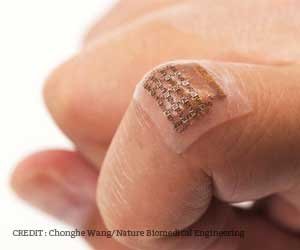New Wearable Ultrasound Device Monitors Deep-Tissues in Moving Subjects

This device that facilitates cardiovascular monitoring not only marks a breakthrough in wearable technology but also in life-saving measures (
).
Deep tissue signals often have a stronger correlation with critical physiological processes, such as circulation and respiration. Medical ultrasound is a highly effective tool for capturing these deep tissue signals.
However, this technology remains inaccessible in people’s lives. Recognizing the challenges posed by the limited availability of ultrasound technology in non-clinical settings, researchers set out to develop a solution.
Advertisement
They aimed to design a fully integrated, autonomous ultrasonic system-on-patch. This patch incorporates both ultrasonic probe and wireless control electronics in a soft, wearable format) Not only is it cost-effective, but it also eliminates the need for a trained operator.
The deep tissue signals captured from the subject are conditioned and pre-processed on-patch, then wirelessly transferred to a backend receiver, where they are analyzed by a customized machine learning algorithm.
This ultrasonic system-on-patch was developed in a manner to capture a broad range of deep tissue signals. From arterial pulse waveforms, the critical parameters associated with cardiovascular diseases can be derived, such as heart rate, blood pressure, and arterial compliance.
From ventricular contractions, the diameter change of the heart chamber during cardiac cycles can be derived, which is a quantitative measure of heart function. The diaphragmatic excursion is a surrogate for lung function, which can be used to characterize typical respiratory volumes and diagnose respiratory issues, such as airway obstruction or lung capacity restriction.
How Effective is Fully Integrated Ultrasound System-On-Patch
To further demonstrate the patch’s capabilities, they conducted a study on a participant during exercise. The participant performed 30 min continuous cycling followed by 30 min rest. Later, recorded the carotid blood pressure waveform and heart rate while the participant moves freely.
They also estimated the stroke volume from the pressure waveforms using a pulse contour method. The cardiac output is then calculated as the product of stroke volume and heart rate.
The results showed that as exercise intensity increased, the measured cardiac output also increased, with the heart rate following suit. The stroke volume increases initially and then plateaued due to limited ventricle size.
Moving Towards Internet-of-Medical-Things
On the backend, the machine learning algorithm used for autonomous data processing appeared to be flawless. However, a common pitfall is the poor generalizability of the algorithm(). Many algorithms struggle to accept data with new features that deviate from the training dataset, and so was ours.
To address this generalization problem, researchers leveraged the domain adaptation technique developed by computer scientists to minimize the data discrepancies between subjects. With minimal effort in data collection from the new subject, the model could adapt to the new subject with high accuracy.
The development of the fully integrated ultrasound patch represents a significant breakthrough in making ultrasound technology accessible for daily healthcare scenarios. With its wireless connectivity, it eliminates the need for cumbersome wires and allows for greater mobility during data acquisition (3✔ ✔Trusted Source
Machine learning for medical ultrasound: status, methods, and future opportunities
Go to source).
The real-time, machine learning-based algorithms automate data processing and analysis, freeing up valuable time and resources for clinicians. Together, these innovations pave the way for continuous surveillance of deep tissue physiology toward the Internet of medical things.
References :
- A fully integrated wearable ultrasound system to monitor deep tissues in moving subjects
– (https://www.nature.com/articles/s41587-023-01800-0
) - Deep Learning in Medical Ultrasound Analysis: A Review
– (https://www.sciencedirect.com/science/article/pii/S2095809918301887?via%3Dihub
) - Machine learning for medical ultrasound: status, methods, and future opportunities
– (https://link.springer.com/article/10.1007/s00261-018-1517-0
)
Source: Eurekalert
Source link
#Wearable #Ultrasound #Device #Monitors #DeepTissues #Moving #Subjects



